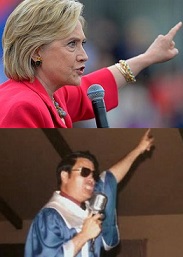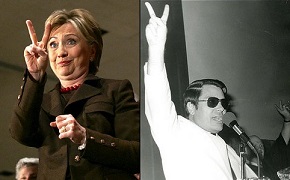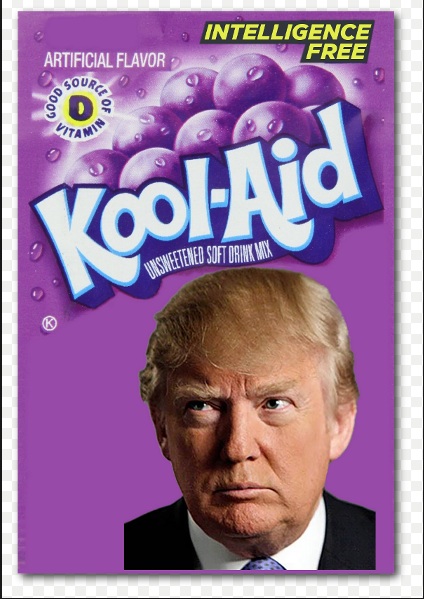The presidential election cycle of 2016 has been interesting for many reasons. Yes, we have all been watching candidates who are considered to be larger than life – whether that is due to membership in a political dynasty, or an alliance with a belief system that the majority of Americans find overly liberal, or even just the flat-out celebrity of a candidate – and that alone makes this upcoming election a departure from politics as usual.
This has also been one of the most polarizing presidential elections in recent history. Pretty much every American has chosen a side in this election between the nominees of the two main political parties, and many of those who have made their choices have also become strong and vocal supporters of their candidates’ platforms. That’s not so uncommon, but the degree of animosity towards the opposing candidate – and his/her supporters – most certainly is.
In this year of political turmoil, we should not be surprised that a very interesting mode of political attack has returned. Numerous online articles and opinion pieces seems to spend a good deal of space on the ways in which one candidate or the other closely resembles Jim Jones. This article will examine a small fraction of these comparisons.
The Democratic Candidate, Hillary Rodham Clinton
Hillary Rodham Clinton, the Democratic Party’s 2016 nominee for president, has been involved in the political arena in one way or another for most of her adult life. She first came to prominence as the First Lady of Arkansas when her husband, Bill Clinton, became governor in January 1979. Working at his side, Hillary championed issues on behalf of the people of Arkansas, most notably advocating for poor children and families. When Bill was elected president in 1992, Hillary assumed the duties of First Lady, while also taking some political initiative of her own, such as her efforts to create a national healthcare system, and – once again – advocating for underprivileged children. She has also been a U.S. Senator, representing the state of New York (2001-2009), and most recently, she served as Secretary of State in the Obama Administration (2009-2013). On April 12, 2015, she declared her candidacy for president, and on July 26, 2016, she was formally nominated as the Democratic Party’s standard-bearer.
 Hillary Clinton’s campaign – and the woman herself – have inspired several comparisons to Peoples Temple and Jim Jones, and they’ve been uniformly uncomplimentary. On May 13, 2016, Daniel Greenfield, writing for frontpagemag.com, began his article “Former Jim Jones Ally Endorses Hillary Clinton” by detailing the relationship which numerous California politicians had with Jones and Peoples Temple during the 1970’s. When the Temple moved its headquarters to San Francisco, Jones and his followers became heavily involved in the city’s political scene. Although it’s now understood that Jones and Peoples Temple likely didn’t bring a lot of votes to the candidates they supported – and certainly didn’t tip the mayoral election of 1975 to George Moscone, as many charged at the time – the group’s political influence was sufficient to make politicians pay attention. In addition to Moscone, political figures such as Supervisors Harvey Milk and Dianne Feinstein, Congressman John Burton, and Governor Jerry Brown all courted Peoples Temple.
Hillary Clinton’s campaign – and the woman herself – have inspired several comparisons to Peoples Temple and Jim Jones, and they’ve been uniformly uncomplimentary. On May 13, 2016, Daniel Greenfield, writing for frontpagemag.com, began his article “Former Jim Jones Ally Endorses Hillary Clinton” by detailing the relationship which numerous California politicians had with Jones and Peoples Temple during the 1970’s. When the Temple moved its headquarters to San Francisco, Jones and his followers became heavily involved in the city’s political scene. Although it’s now understood that Jones and Peoples Temple likely didn’t bring a lot of votes to the candidates they supported – and certainly didn’t tip the mayoral election of 1975 to George Moscone, as many charged at the time – the group’s political influence was sufficient to make politicians pay attention. In addition to Moscone, political figures such as Supervisors Harvey Milk and Dianne Feinstein, Congressman John Burton, and Governor Jerry Brown all courted Peoples Temple.
As were numerous commentators of the period, Greenfield is critical of the relationships that these politicians had with Jones, but the author has special disdain for Jerry Brown’s past support of Jones. The fact that that relationship ended more than forty years ago doesn’t mean anything. According to Greenfield, Jerry Brown’s endorsement of Hillary Clinton for president earlier this year is equal to his support of Jim Jones.
Greenfield then adds that “Jerry has decided to drink Hillary’s Kool-Aid,” suggesting that Brown’s support of Hillary’s policies will be mindless and robotic, thereby smearing two Democratic politicians with one loaded cliché.
In March 2016, a blogger going by the single name of Chedoh wrote on peoplescube.com about the similarities that some people see between Hillary Clinton and Jim Jones. Quoting Forensic Psychologist Jason McKay, the author states that Secretary Clinton has been “clearly mimicking the body language and speech structure” that Jim Jones used when addressing African American audiences in order to curry favor with minority voters. McKay also states that, during a campaign rally, Hillary “was consciously manipulating the crowd of minority voters to get them to follow her unconditionally, without question,” and that Hillary “is borrowing her techniques directly from Jim Jones. There’s no doubt about it.” Chedoh himself (or herself) completes the analogy: “Jones’ deception relied heavily on [the] politics of social justice and redistribution of wealth, which he used to ‘hypnotize’ and ‘brainwash’ his followers.” How could anyone conclude otherwise, Chedoh asks: the body language and speech patterns, the racial make-up of the audience, the underlying principles, they’re all the same for both Hillary Clinton and Jim Jones.
 In March 2016, a blogger for abovetopsecret.com compared, not the two leaders themselves, but their respective followers. Kshikehe – single name – notes that when supporters of Hillary are exposed to information painting her in an unfavorable light, not only do they show no interest in that new information, but that “they seem to harden their position on her, regardless of how bad that information is. It reminds me of Jim Jones… [who] had rabid, sycophantic supporters who could not be persuaded by logic.” There are other, more sinister similarities, between the two camps. “[I]f Hillary told [her supporters] to drink the Kool-Aid, you know they would do it for her.”
In March 2016, a blogger for abovetopsecret.com compared, not the two leaders themselves, but their respective followers. Kshikehe – single name – notes that when supporters of Hillary are exposed to information painting her in an unfavorable light, not only do they show no interest in that new information, but that “they seem to harden their position on her, regardless of how bad that information is. It reminds me of Jim Jones… [who] had rabid, sycophantic supporters who could not be persuaded by logic.” There are other, more sinister similarities, between the two camps. “[I]f Hillary told [her supporters] to drink the Kool-Aid, you know they would do it for her.”
Kshikehe’s final snipe at the Democratic candidate is a very simple, but powerful, three-word sentence: “Welcome to Hillarytown.” After all the comparisons to Peoples Temple, is there any question what Hillarytown is?
Rhett – again, there is no last name given – of the “SayWhatNews?! Blog” also refers to Clinton supporters as “drinking the Hillary Kool-Aid,” then goes a step further, claiming that they are “being led to their slaughter, politically.” Rhett opines that Secretary Clinton’s political record is riddled with political wrongdoing, and that those who vote for her in November will be forever “injured” by her election. “Hillary Rodham Clinton was, is, and will always be a two-bit political hustler,” Rhett continues, “just as Jim Jones was a psychopathic religious hustler.” In case the reader doesn’t get the message, the author goes on to call Hillary “a political and veritable ‘cult of personality’… Hillary Clinton is the Jim Jones of our modern political era.”
The Republican Candidate, Donald Trump
Donald Trump, the “Billionaire Businessman” from New York, is the Republican Party standard-bearer in the 2016 election. Trump has always had a reputation for being brash, and has kept himself in the public’s view through such vehicles as the reality television show, “The Apprentice,” the Miss Universe beauty contest, flamboyant casinos and exclusive golf courses bearing his name, and – seemingly more respectable but perhaps even more controversial – Trump University and the Trump Foundation. Trump has no experience in the political realm, and has based his campaign upon his own descriptions of his success as a businessman. Along the way, Trump has made both friends and enemies with his blunt, and – at times – uncouth remarks on national issues and rival political candidates.
Like Hillary Clinton, Trump has also had online critics compare him to Jim Jones and the negative personal qualities that such a comparison invokes. Writing for targetliberty.com in January of 2016, Robert Wenzel described a book-club meeting he had with Debbie Layton in San Francisco to discuss Layton’s book, Seductive Poison, about her experiences in Peoples Temple and with Jim Jones. “I asked her if she saw any Jones-like characteristics in any of the Presidential candidates, specifically Donald Trump,” Wenzel wrote. “ ‘What about the masses he is getting to follow him’, I asked, ‘Is that Jones-like?’ [Layton] said, ‘No’, but she added, ‘Donald Trump really scares me’.”
Another online author, Stop Gun Insanity on the stop-gun-insanity.newsvine.com site – don’t any of these people have real names? – headlined his/her piece: “Just like Jim Jones got his followers to swallow the poisoned Kool-Aid, Trump is getting Middle-Class Republicans to vote against their best interests.” Indeed, in regards to the economic policies that he proposes to enact as president, Trump has managed to win the support from many voters in the lower and middle ranges of American socio-economic levels, even though the plans that the candidate has put on his campaign website – such as lowering taxes for those in the upper class financial bracket – would be of absolutely no benefit to the majority of Americans.
 While on the campaign trail in November 2015, Trump met a supporter who appeared at the rally dressed as Trump, and who acknowledged that he impersonated Trump elsewhere, even when he was with his wife. Trump was so taken by the tribute that he mentioned it in his address to the crowd. Writing for the addictinginfo.org website, Kerry-Anne No Last Name said she felt “like the ‘Impersonator Donald’ would be only too happy to hand his wife over to curry favor with his ‘Glorious Leader.’ The whole thing feels more like some Jim Jones style cult than a political campaign.” Obviously disturbed by what she saw, the author ended the article with the plea, “America – do not drink the Kool-Aid.”
While on the campaign trail in November 2015, Trump met a supporter who appeared at the rally dressed as Trump, and who acknowledged that he impersonated Trump elsewhere, even when he was with his wife. Trump was so taken by the tribute that he mentioned it in his address to the crowd. Writing for the addictinginfo.org website, Kerry-Anne No Last Name said she felt “like the ‘Impersonator Donald’ would be only too happy to hand his wife over to curry favor with his ‘Glorious Leader.’ The whole thing feels more like some Jim Jones style cult than a political campaign.” Obviously disturbed by what she saw, the author ended the article with the plea, “America – do not drink the Kool-Aid.”
In a Guest Column for the Richmond Times, Erika Raskin of erikaraskin.net opens with an acknowledgement that she wrote her Senior Thesis on “Jim Jones and the rise of American-shaped fascism.” With that as her backdrop for her piece, she compares “Donald Trump and Jim Jones to one another in regards to the psychological methods that they employ[ed], and found five very interesting similarities between the two men.” Both Trump and Jones utilize “the art of the scam”: she feels that Trump University and the false hope that it promised, is comparable to Jones’ use of “faith healings” in order to draw in the masses (and of course, both resulted in financial benefits to the two men). Erika also highlights how both men used “media control,” with Trump relying upon his “wall-to-wall coverage on cable” to project the image of himself that he wants the voters to see; Jones used his pulpit to deliver his opinions and persuade people. The third concept, “Shape-shifting,” refers to an individual’s ability to play whatever part is needed for a particular audience: while Trump uses “dog whistles” and speaks “out of both sides of his mouth” in order to convince voters that he shares their sentiments, it’s also well-documented that Jones used speech patterns and mannerisms of his black followers to convince them that he “embodied their hopes ideals for a decent society.” Both Trump and Jones also use “rage as control,” i.e., displaying anger in order to quell any threats to their authority. Trump does this by bullying and calling people names if they question his assertions about a variety of subjects; Jones dealt with any challenges to his authority with both verbal humiliation and physical punishment. Finally, according to Raskin, both Trump and Jones used similar psychological methods in “the creation of a common enemy and the fanning of paranoia.” Jones most definitely “delineated a them/us split… [and] stoked his followers’ fears of nuclear war, governmental overreach, and American racism,” whereas Trump “has tapped into a vein of economic insecurity among whites, while playing cute with the Klan.”
Conclusion
In any political season, there are cultural icons – both heroes and villains – which both political parties will use, either to support their own candidates or tear down the other guy’s. Some are reserved for one side or the other – Barack Obama and Bill Clinton are heroes for Democrats and villains for Republicans; John McCain and Antonin Scalia get more traction in Republican circles than in Democratic ones – but some are more quoted by both sides. Michelle Obama wins the respect among many Republicans, especially those seeking the woman’s vote; Donald Trump has quoted Bernie Sanders on many occasions, especially when he put himself in Sanders’ corner against Clinton. And everybody – including many Democrats – likes to quote Ronald Reagan.
But then there are the universal bugaboos. If you see a political ad featuring Osama bin Laden or Vladimir Putin, you can pretty much guarantee it’s an attack ad against an opponent, and not an endorsement of anyone. But for sheer staying power – to serve as the villain for almost 40 years and still be recognizable as such – it’s difficult to imagine anyone as resilient as Jim Jones.
As a political prognosticator, I can’t predict with any certainty which 2016 presidential candidate will take Ohio or Iowa or Arizona. But I can lay solid odds that Jim Jones will be on the ballot – once again – in 2020.
(Other examples comparing Hillary Clinton to Jim Jones include Hillary Clinton- the 2016 Jim Jones candidate, a March 17, 2015 article by Dr. John on Flopping Aces; and Hillary Clinton Announces Presidential Run Jim Jones Style, an InfoWars video hosted by Alex Jones on June 15, 2015.)
(Other examples comparing Donald Trump to Jim Jones include a June 14, 2016 blog from the Washington Post, Trump Is Close to the Abyss; a September 1 article by David Ferguson on RawStory, Drinking the Orange Kool-Aid; an October 13 column in Daily Kos, Donald Trump as Jim Jones; and an October 27 opinion piece in Inglewood (Calif.) Today, “Who’s More Dangerous—Jim Jones or Donald Trump?”.)
(Bonnie Yates is a regular contributor to the jonestown report. Her previous articles may be found here. She may be reached here.)